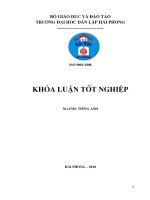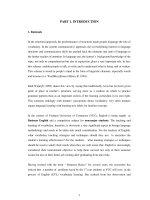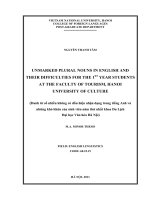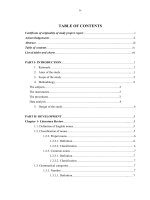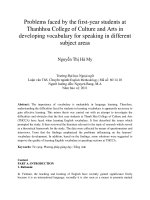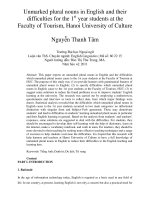SYNONYMS AND TYPICAL ERRORS MADE BY the 1st YEAR STUDENTS AT THE FACULTY OF TOURISM, HANOI UNIVERSITY OF CULTURE
Bạn đang xem bản rút gọn của tài liệu. Xem và tải ngay bản đầy đủ của tài liệu tại đây (84.77 KB, 12 trang )
UNIVERSITY OF LANGUAGES AND INTERNATIONAL STUDIES VIETNAM
NATIONAL UNIVERSITY OF HANOI
POST-GRADUATE DEPARTMENT
======***======
SYNONYMS AND TYPICAL ERRORS MADE BY
the 1st YEAR STUDENTS AT THE FACULTY OF
TOURISM, HANOI UNIVERSITY OF CULTURE
Subject: Semantics
Name : Nguyen Thanh Tam
Group: K18C
Lecturer : Dr. Ha Cam Tam
Deadline: 28/6/2010
Hanoi – June, 2010
1. INTRODUCTION
1.1. Rationale
Each person in their life gets involved in many kinds of communication. One obvious
thing is that different words used have different effect on the success of
communication. To communicate successfully, we have to use sounds in the form of
words, structures, sentences and choose suitable ones for different communication.
Among them, words can be said the most basic unit. Choosing the right word is not
easy at all because it requires the knowledge of speakers of words. In fact, there are
many words that are very similar in meaning but different in shade of meaning.
Sometimes, students get confused in determining what word is more correct. For
example, students may wonder whether they should use ‘persuade’ or ‘convince’,
‘brilliant or wonderful’, ‘die or pass away’. The wrong choice may lead to serious
problems. Therefore, I find that studying into ‘Synonyms and typical errors made by
the 1st year students at the Faculty of Tourism, Hanoi University of Culture’ is very
important. This will help students to choose and use suitable words in their
communication to improve the effect of communication.
1.1.
Aims and objectives of the study
This study is aimed at:
- Giving theoretical background on synonyms: definitions, classification and sources.
- Making clear about the typical errors in using synonyms by the 1 st year students at the
Faculty of Tourism, Hanoi University of Culture.
- Giving some suggestions to help students understand the shade of meaning and use
suitable synonyms in different communicative situations.
1.2.
Scope of the study
The study, due to the limit of length, cannot cover the whole field relating to English
synonyms. It only focuses on the following points:
- Major theoretical background on synonyms
- Investigation into using synonyms of the 1st year students at the Faculty of Tourism,
Hanoi University of Culture
2
1.3.
Methods of the study
The study uses the following methods:
- Qualitative: interviewing 20 first year students, interpreting the students’ drafts to see
what they had done.
- Quantitative: collecting typical errors made by students in their daily conversations
and their writings.
2. DEVELOPMENT
2.1. English synonyms
2.1.1. Definition of English synonyms
The word synonym is a composite of two Greek words: The prefix “syn” means
“together” and “onym” is “name.” Therefore, synonyms- naming the same thing.
According to John I. Saeed, (2003), “Synonyms are different phonological words which
have the same or very similar meanings”.
In ‘An Introduction to Semantics’, Nguyen Hoa defines synonyms as follows:
“Synonyms are actually words of the same parts of speech which have similar
meaning, but not identical meaning. They may share a similar denotational or
connotational meaning. They can differ from each another in terms of denotation or
connotation.”
In the book ‘English lexicology’, Nguyen Manh Hung writes “Synonyms are words
belonging to the same parts of speech and possessing one or more identical or nearly
identical denotational meaning interchangeable in some texts”.
This is the definition from />‘Synonyms are different words with identical or very similar meanings. Words that are
synonyms are said to be synonymous, and the state of being a synonym is called
synonymy.’
3
In general, different scholars give different definitions about synonyms. In short,
synonyms are words or phrases which share the exact same meaning or a very similar
meaning.
For example:
•
Beautiful-pretty
•
Teenager-adolescent
•
Baby-toddler
•
Mother-mommy
Words from any part of speech (e.g. nouns, verbs, adjectives, adverbs or prepositions)
can have synonyms, as long as they both have the same part of speech.
For example:
•
Amazing, awesome, incredible, astonishing (adjectives)
•
Car, auto, automobile, motorcar (nouns)
•
Participate, take part, join (verbs)
•
Quickly, fast, promptly (adverbs)
•
On, upon (prepositions)
2.1.2. Classification of English synonyms
2.1.2.1. Absolute synonyms
Absolute synonyms are the words with fully identical meanings and stylistic
characteristics. One can always be substituted for the other, e.g: fatherland,
motherland, etc.
Absolute or perfect synonyms are very rare in the vocabulary and in the diachronic
level, the phenomenon of absolute synonyms is anomalous and consequently
temporary the vocabulary system invariably tends to abolish it either by rejecting one
of the absolute synonyms or by developing differentiation characteristics in one or both
of them.
4
For example:
Semantic
vs. semasiology
Noun
vs.
Flexion
vs. inflexion
substantive
2.1.2.2. Semantic synonyms
They are words differing in the shades of meaning. They make up a large number of
English synonyms.
e.g: beautiful, pretty and handsome.
All of them have the criterion of common denotation ‘good looking’. Each of them
creates its own feature of human beauty.
‘To stare’, ‘to glare’, ‘to gaze’, ‘to glance’ all denote an act of looking at somebody or
something but ‘stare’ is looking steadily lastingly in surprise and curiosity. ‘Gaze’ is a
steady looking with admiration and ‘glance’ is brief looking.
The words which belong to this kind make clear the objective difference of the object
mentioned. They are less interchangeable.
2.1.2.3. Stylistic synonyms
They are words differing in the stylistic aspects. They often differ not so much in
meaning as in the emotional saturation. They are exactly the same meaning but differ
in the use sphere (used in poetry, spoken language, formal and informal language). In
such a synonymic group, there is a ‘central’ word or ‘neutral’ word or synonymic
dominant. Other words denote the notion common but with different color.
For example, ‘to die, to pass away’; ‘Policeman, cop, officer’ are synonyms. When
conveying neutral emotion, you can use ‘policeman’ but when you express your
contempt, the word ‘cop’ is used.
In this synonymic group, the use of archaic synonyms is a common stylistic device.
Older words are often rich in connotation. Archaisms or attempt at their revisal to a
desire for novelty, a feeling foe a less worn expressing. Poet always uses old words:
1. Billow – wave
4. Changer – merchant
2. Maid – girl
5. Mere – pond, late
3. Be like – probably
6. oft – often
5
Semantic synonyms concern with euphemisms. They are used to avoid the words that
are considered indecent, indelicate, rude, too died or impolite. For example, the word
‘glance’ and ‘look away’ are synonyms. We know that ‘look’ is the most neutral
member and simply mean ‘turn one’s eyes in a particular direction in order to see’. On
the other hand, apart from these semis, ‘glance’ suggests ‘a quick and stolen look’.
Meanwhile, ‘pregnancy’ is another topic for ‘delicate’ references. Here are some of the
euphemisms used as substitutes for the adjective ‘pregnant’: an interesting condition,
in the family way, with a baby coming.
2.1.2.4. Semantic stylistic synonyms
They are words differing in both the shades of meaning and the stylistic aspect. E.g: to
dismiss, to fire, to sack. In which of them, ‘to dismiss’ is a neutral word, the idea of
giving permission to go is often implied. However, ‘to fire’ is slang and used with the
idea of forcing to go unwillingly.
For example, ‘to agree’ and ‘to consent’ are the most general words, the idea of
agreement with what someone else has stated or proposed is express without any
qualification. ‘She agreed to his plan but she was prettily sure that his mother would a
stop to it’. ‘Consent’ expresses the more complete agreement. It involves the will or the
feeling and it is a literary word.
2.1.2.5. Phraseological synonyms
They are the words that have the same meaning in certain collocations and another in
others. Such synonyms are called phraseological synonyms. Words of this group
belong to the same stylistic type. E.g: to make and to do
To make
Tea, coffee
To do
Business
An error
Exercises
A fire
Homework
Money
Painting
6
‘To do’ and ‘to make’ in regard to person are both used in the sense of voluntarily
exerting a power to bring a thing to pass but ‘to do’ applies to the ordinary business of
contrivance or purposes. What is done once may have been brought into existence.
Here, the meaning of ‘make’ is to produce or construct and the meaning of ‘do’ is ‘to
carry out, to perform’. However, ‘make’ and ‘do’ often deviate from their meanings if
used idiomatically. Such idiomatic use can only be mastered by experience. Or another
example, ‘meaning’ and ‘sense’, we can say ‘The word has two senses or the word has
two meanings’ but not ‘He is a man of meaning’. We can only say ‘He is a man of
sense’.
2.1.2.6. Territorial synonyms
They are words that belong to different countries and have the same meaning large
territories for many centuries for territories and economical reasons. It is not only the
official language of the Britain but also USA, Canada and Australia. In these countries,
there appear many words that exist with exact British equivalents. All of them form the
territorial synonyms.
For example:
British English
Autumn
American English
Fall
Vest
Undershirt
Toilets
Restroom
Waistcoat
Vest
Car park
Parking lot
Trainers
Sneakers
Cinema
Movie theatre
Jumper
Sweater
All synonyms are less different in connotation. Using them depends on where you live.
It is simply a matter of people speaking different form of the language having different
vocabulary items.
7
What are mentioned above are kinds of synonyms. Among them, semantics stylistic
synonyms are the most important. They take up the majority of English vocabulary.
They are used vary much to represent the same phenomenon in different aspects,
shades and variations.
2.1.3. Sources of synonyms
2.1.3.1. Borrowings
Many words were borrowed from Greek, Latin and French and they become synonyms
to native words forming the synonymic groups in which the native words are usually
neutral, French words are literary, Latin and Greek are bookish or scientific.
e.g: to end – to finish – to complete
belly – stomach – abdomen
2.1.3.2. The change of meaning
The word ‘hand’, for example, acquired the meaning ‘worker’ and became synonym to
this word, then the meaning ‘side, direction’ (hand side), signature (hand signature).
2.1.3.3. Word building
Creation of phrasal verbs
e.g: to rise, to get up; to get off the ground, to take off the ground
Conversion
e.g. laughter – laugh
Shortening
e.g: popular -pop
bicycle -bike
microphone -mike
Means of deviation and composition
e.g: deceptive –deceitful
trader – tradesman
periphery – circumference
2.2.
Errors made by the 1st year students at the Faculty of Tourism.
8
Through the results of the test, especially some information collected from the
interview with 20 1st year students at the Faculty of Tourism, errors in using English
synonyms of students are found out.
Most of the students who are interviewed said that synonyms could be used
interchangeably and substituted in all contexts. They cannot tell the difference between
words in each synonymic group. As a result, they have problems in learning synonyms
among which how to understand their shade of meaning and use suitable synonyms in
different contexts are the biggest.
It cannot be denied that vocabulary errors manifest one or more kinds of dissonance
between the word and its context. From the collected data, the four dissonances that
interfere with encoding by students are stylistic, syntactic, collocational and semantic.
2.2.1. Stylistic errors
e.g: dunk the chicken pieces in the beaten egg mixture
2.2.2. Syntactic errors
e.g: The author purports that tobacco is harmful.
2.2.3. Collocational errors
e.g: I used to be a large smoker.
This kind of error seems to be often made by students. For example, they think that the
two sentences ‘She is making a big mistake vs. she is making a large mistake’ are the
same. In fact, the sentence ‘She is making a large mistake’ is grammatically well
formed, meaningful. However, it is unacceptable collocationally. Unfortunately, it is
very difficult for students to find out the correct words in these situations.
2.2.4. Semantic errors
e.g: I was badly damaged in the accident.
2.3. Suggestions to avoid mistakes
Above, some typical mistakes made by the 1st year students at the Faculty of Tourism
are pointed out. It is clear that how to understand the shade of synonyms’ meaning and
use suitable ones in different contexts are the biggest.
Some of these errors are the result of the first language transfer but the majority are
interlingual, i.e., they reflect confusion between and among items in the second
9
language itself. Hence, with the aim to help teachers and students of English to avoid
mistakes, I would like to present several suggestions which I hope useful and
advisable.
First of all, teachers cannot hope to present new vocabulary so thoroughly that students
will never misuse it, but they can aspire to prevent some of the misconceptions that
lead to erroneous use. The real challenge comes when a student choose a wrong word
when speaking or writing; the teacher has the delicate task of explaining what has gone
awry rather than merely telling the students to discard one word in favor of another – a
procedure that usually leaves the students mystified and in no position to avoid a
similar misstep in the future.
Besides, teachers should design more activities and give students more exercises on
synonyms to practise for “practice makes perfect”. If these activities happen with high
frequency, they will help strengthen students’ concept of words and develop their
vocabulary. Moreover, teacher should encourage students to use synonyms to add
flavor to their speech and writing because if everything (person, place, object…) in the
world had only one word to refer to it, the world would be a very boring place.
For their part, students should not learn passively what teachers ask to or in the way
teachers instruct. In stead of that, they should have their own methods. It is obvious
that regular practice and a good way of learning will bring them solid theoretical
knowledge.
3. CONCLUSION
This assignment has been an attempt at providing readers with background knowledge
about synonyms. In the assignment, a theoretical background on English synonyms has
been given. Through the analysis, there emerges some problems of students’ learning
synonyms among which how to understand their shade of meaning and use suitable
synonyms in different contexts are the biggest.
10
The use of synonyms is crucial for students to translate and interpret from a language
into another language. In order to make language a lot more expressive and interesting
they should try to vary the words they use as often as they can (but not too often).
That’s where synonyms come into the picture.
It is hoped that this study, to some extent, will be of attention and of significance in the
improvement fo teaching and learning English.
REFERENCES
11
1. Hoa, Nguyen. (2001). An Introduction to Semantics. Hanoi. VNU Press.
2. Saeed, John I. (2003). Semantics. Blackwell publishing.
3. Gregory, H. (2000). Semantics. London. Routledge.
4. Marilyn, M. (1984). Advanced Vocabulary Teaching. Blackwell Publishing.
5. Hung.N.M, (2000). English lexicology. Ha Noi University. Education
Publishing House.
6. />7.
8. />
12

